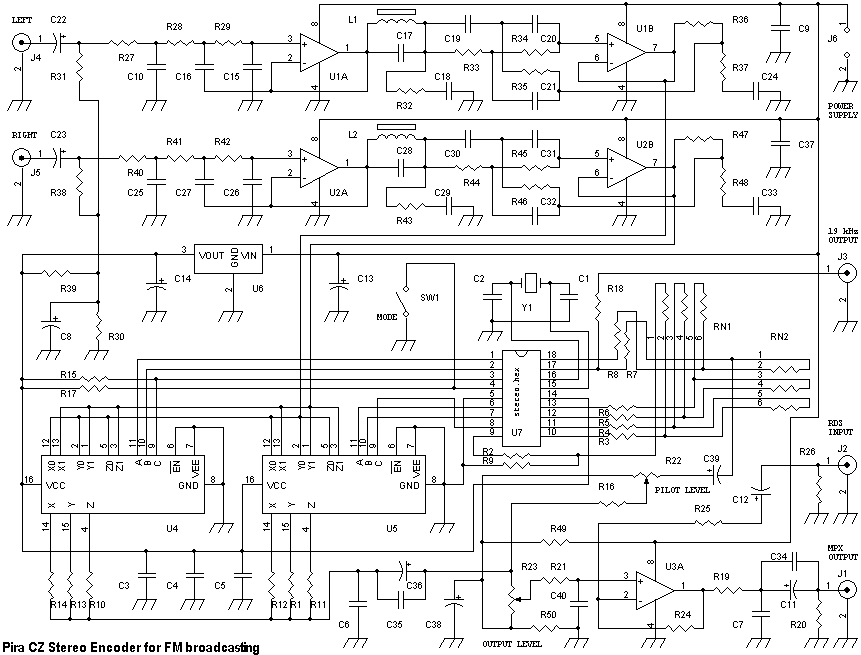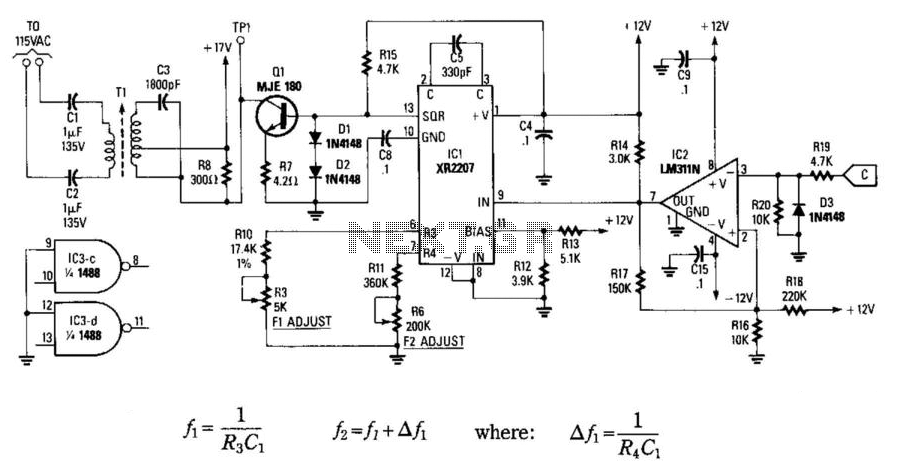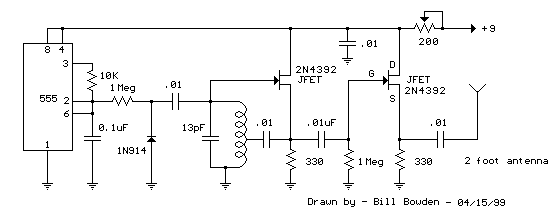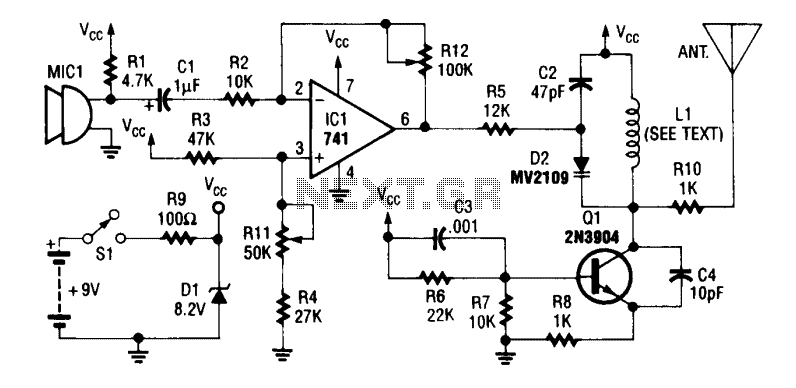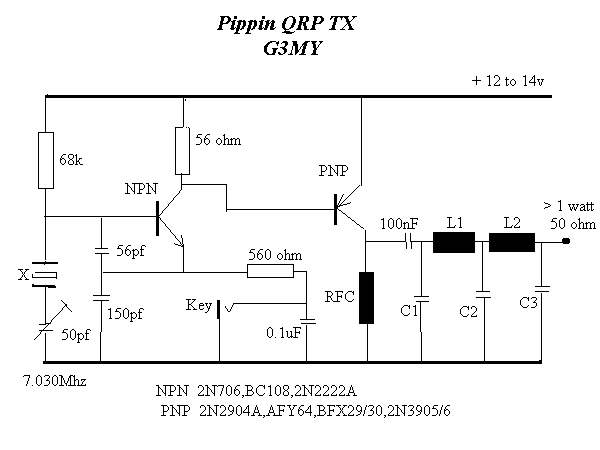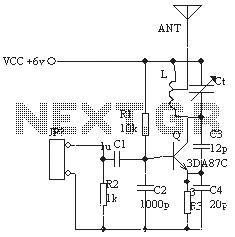
Spy FM Transmitter
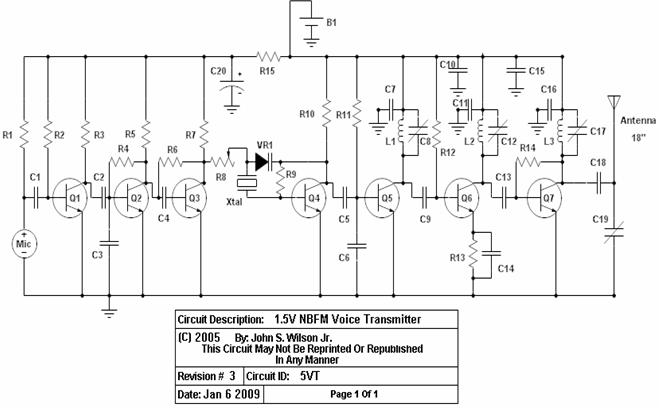
Construct this circuit utilizing a Digi-Key Electronics Barrel Crystal (CA-301) with a frequency of 15 MHz to achieve a standard output frequency of 150.00 MHz. For frequency customization, follow the provided instructions. Typically, this circuit is designed to operate within a frequency range of 150 to 165 MHz. The crystals employed are the Digi-Key Electronics Barrel Crystals CA-301 type, which are relatively inexpensive. This circuit incorporates an X5 multiplier followed by an X2 multiplier in the final stage. For instance, using a 15 MHz Barrel Crystal, the output frequency at Q4 is calculated as: Xtal x 5, resulting in 75 MHz at Q5. Q5 then multiplies 75 MHz by 2, yielding a final output frequency of 150.00 MHz at Q6. Any fundamental crystal within the range of 14 to 17 MHz can produce frequencies between 140 to 170 MHz, provided the crystal has a load capacitance of approximately 18 pF. To create a transmitter at a custom frequency, apply the X5 X2 formula and order a custom cut crystal with an 18 pF load capacitance. A recommended crystal would have a fundamental frequency of 15.825 MHz, a tolerance of 0.001%, and a load capacitance of 18 pF. When tuning the transmitter, the output transmit frequency would be 158.250 MHz. The original circuits mentioned were produced and sold in large quantities to law enforcement agencies, with research and development costs amounting to over a million dollars by current standards.
The circuit design integrates a frequency multiplier approach to achieve the desired output frequency. The initial stage utilizes a 15 MHz crystal oscillator, which serves as the frequency source. The X5 multiplier stage amplifies the fundamental frequency to 75 MHz. This stage typically employs a transistor configured as a common emitter amplifier, which provides the necessary gain while maintaining signal integrity. The output of the first multiplier is then fed into the second stage, the X2 multiplier, which further doubles the frequency to achieve the target output of 150 MHz.
The choice of the Digi-Key Electronics Barrel Crystal CA-301 is crucial due to its stability and low cost. The crystal's specifications, particularly the load capacitance of 18 pF, are essential for ensuring optimal performance of the oscillators and multipliers. The circuit should be designed considering the impedance matching between stages to minimize signal loss and distortion.
The final output stage, Q6, must be configured to handle the amplified frequency while providing the necessary output power for transmission. This may involve additional filtering to remove harmonics and unwanted signals, ensuring compliance with transmission standards. The design should also incorporate proper power supply decoupling and bypassing to maintain stable operation across varying load conditions.
Overall, this circuit exemplifies a practical application of frequency multiplication techniques in RF design, suitable for various communication systems, including those used by law enforcement. The modular approach allows for flexibility in frequency selection, enabling the adaptation of the circuit for different operational requirements.Build this circuit using a Digi-Key Electronics Barrel Crystal (CA-301), 15 Mhz for a standard output frequency of 150. 00 Mhz. If you want to customize the frequency, follow the directions below. I usually build this circuit to operate between 150 to 165 Mhz. The Crystals I use Are The Digi-Key Electronics Barrel Crystals CA-301 Type which cost a couple of bucks per crystal.
This circuit uses a X5 Multiplier and then a X2 Multiplier In the Final. Example: If I use a 15 Mhz Barrel Crystal, the frequency at Q4s output is: Xtal X 5 Or: 75 Mhz into Q5. Q5 Multiplies 75 Mhz X 2 for an end frequency out of the final Q6 ( Desired Output Frequency ) of 150.
00 Mhz. Virtually any Fundamental Crystal between 14 and 17 Mhz will output a frequency of between 140 to 170 Mhz, if the crystal has a load capacitance of around 18 pf. If you wish to build this transmitter on A custom frequency simply use the X5 X2 formula below and order a custom cut crystal specifying an 18 pf CL.
I would order the crystal at a Fundamental frequency of 15. 825 Mhz, tolerance of. 001% and a Crystal Load Capacitance of 18 pf. When I tune my transmitter, my output transmit frequency would be: 158. 250 Mhz. The Original Circuits Below Were Built and Sold - In The Thousands To Law Enforcement. Their Original Research and Development Cost, By Today`s Standards, Would Total - Well Over A Million Dollars. 🔗 External reference
The circuit design integrates a frequency multiplier approach to achieve the desired output frequency. The initial stage utilizes a 15 MHz crystal oscillator, which serves as the frequency source. The X5 multiplier stage amplifies the fundamental frequency to 75 MHz. This stage typically employs a transistor configured as a common emitter amplifier, which provides the necessary gain while maintaining signal integrity. The output of the first multiplier is then fed into the second stage, the X2 multiplier, which further doubles the frequency to achieve the target output of 150 MHz.
The choice of the Digi-Key Electronics Barrel Crystal CA-301 is crucial due to its stability and low cost. The crystal's specifications, particularly the load capacitance of 18 pF, are essential for ensuring optimal performance of the oscillators and multipliers. The circuit should be designed considering the impedance matching between stages to minimize signal loss and distortion.
The final output stage, Q6, must be configured to handle the amplified frequency while providing the necessary output power for transmission. This may involve additional filtering to remove harmonics and unwanted signals, ensuring compliance with transmission standards. The design should also incorporate proper power supply decoupling and bypassing to maintain stable operation across varying load conditions.
Overall, this circuit exemplifies a practical application of frequency multiplication techniques in RF design, suitable for various communication systems, including those used by law enforcement. The modular approach allows for flexibility in frequency selection, enabling the adaptation of the circuit for different operational requirements.Build this circuit using a Digi-Key Electronics Barrel Crystal (CA-301), 15 Mhz for a standard output frequency of 150. 00 Mhz. If you want to customize the frequency, follow the directions below. I usually build this circuit to operate between 150 to 165 Mhz. The Crystals I use Are The Digi-Key Electronics Barrel Crystals CA-301 Type which cost a couple of bucks per crystal.
This circuit uses a X5 Multiplier and then a X2 Multiplier In the Final. Example: If I use a 15 Mhz Barrel Crystal, the frequency at Q4s output is: Xtal X 5 Or: 75 Mhz into Q5. Q5 Multiplies 75 Mhz X 2 for an end frequency out of the final Q6 ( Desired Output Frequency ) of 150.
00 Mhz. Virtually any Fundamental Crystal between 14 and 17 Mhz will output a frequency of between 140 to 170 Mhz, if the crystal has a load capacitance of around 18 pf. If you wish to build this transmitter on A custom frequency simply use the X5 X2 formula below and order a custom cut crystal specifying an 18 pf CL.
I would order the crystal at a Fundamental frequency of 15. 825 Mhz, tolerance of. 001% and a Crystal Load Capacitance of 18 pf. When I tune my transmitter, my output transmit frequency would be: 158. 250 Mhz. The Original Circuits Below Were Built and Sold - In The Thousands To Law Enforcement. Their Original Research and Development Cost, By Today`s Standards, Would Total - Well Over A Million Dollars. 🔗 External reference
